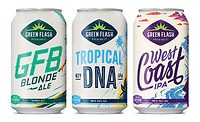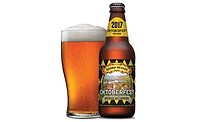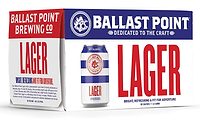2012 Craft Beer Report: Honing their craft
A look at what’s driving the craft beer segment


Five craft beers, including Deschutes Brewery’s Chainbreaker White IPA, were among the Top 15 new beer brands this summer in supermarkets, according to SymphonyIRI Group data.

Variety packs, like The Boston Beer Co.’s Samuel Adams American Originals, have helped craft beer exposure with consumers, experts note.

Available in 16-ounce cans, Narragansett Brewing Co. released its Cream Ale earlier this year. Although glass packaging dominates craft beer case sales, more brands are packaging in cans, according to Nielsen data.

MillerCoors’ Tenth and Blake corporate-owned craft-style beer, Leinenkugel’s Big Eddy Baltic Porter is available in four-packs. Four-pack glass sales have seen strong growth this year, says Dan Wandel senior vice president of beverage alcohol client insights with SymphonyIRI Group.





After enduring contraction the last few years, the overall beer market is on the uptick, says Dan Wandel, senior vice president of beverage alcohol client insights for Chicago-based SymphonyIRI Group. He adds that case sales for beer are up 3.2 percent and dollar sales are up 6.6 percent for the 52 weeks ending Oct. 7 in total U.S. multi-channel outlets covering supermarkets, drug stores, mass market retailers, gas and convenience stores, military commissaries and select club and dollar retail chains. Showcasing similar numbers, Andrea Riberi, senior vice president of the professional services group for New York-based Nielsen, states that year-to-date through Oct. 15, the overall beer category is up 2.1 percent in case sales and 5.4 percent in dollar sales.
Although the overall beer category faced its share of challenges in previous years, one segment that has flourished in the last few years has been the craft beer segment. According to SymphonyIRI data, craft beer case sales were up approximately 12.3 percent and dollar sales were up 16.2 percent during the 52 weeks ending Oct. 7. According to Nielsen data, craft cases have grown 13.3 percent and dollar sales grew 16.3 percent in the 52 weeks ending Oct. 15, Riberi reports.
“This segment continues to fuel the beer category,” SymphonyIRI’s Wandel says. “It’s getting a lot more help this year in the form of new product innovation that’s helping to drive some of the domestic segments as well as imported beer and progressive adult beverages. The flavored malt beverages are bouncing back quite nicely as well.”
But case and dollar sales aren’t the only areas that have contributed growth to the craft brewing industry. In its mid-year report, the Brewers Association, Boulder, Colo., released that as of June 30, 2012, the United States boasted 2,126 breweries — an increase of 350 since June 2011 — 2,075 of which are craft breweries. Also, the Brewers Association estimates that 1,252 breweries are in planning.
In fact, Chico, Calif.-based Sierra Nevada Brewing Co., the No. 2-selling craft beer brand family according to SymphonyIRI data, announced in January that it will build an East Coast brewery in western North Carolina for its second brewery. The new facility will add much needed capacity for Sierra Nevada’s production and will allow for quick shipment of brewery-fresh beer to its East Coast consumers, the company said. Sierra Nevada anticipates the new brewery to be operational by early 2014.
Trending numbers
Although it is easy to acknowledge the success that craft brewing has experienced in the last few years, pinpointing the reasons for that success can be more challenging.
“There are a couple of trends,” Nielsen’s Riberi says. “First, in terms of the store universe, the number of beer outlets has expanded significantly, so the consumer exposure to beer is growing. There’s about 50,000 new locations selling beer in just the last three years and that has really impacted craft. For example, craft has expanded significantly in [convenience] stores; their case volume in [convenience] stores is up 20.3 percent, which is huge.”
Craft beer also indexes high — at 145 — with the millennial demographic, Riberi adds, although its index is lower — at 85 — with the growing Hispanic population.
SymphonyIRI’s Wandel also sees a strong tie between consumer demographics and craft beer. “I think certainly today’s consumer demographics, the younger consumers, are variety seekers,” he says. “They’re looking for bold, new flavors, which plays into the strength of craft beer, which offers a lot of choice. It also offers a lot of bold style, and I think that certainly is a key contributor.”
The local tie also is a trend that craft beer has benefited from in both consumer packaged goods and on-premise, Wandel adds. Given the number of breweries in planning stages as reported by the Brewers Association, more regions are likely about to get local breweries, says Jennifer Zegler, beverage analyst with Chicago-based market research firm Mintel.
“Consumers are really enjoying the ability to be able to purchase something that was brewed locally in the aspect of brew pubs and microbreweries and nano-breweries — these really small breweries that … you can’t go to the supermarket and buy their beers, but you’re able to walk in and talk to the brewers and learn more about the beers,” Zegler says. “It’s really that hands-on, local experience that I think people really enjoy with some of these very, very small start-ups.”
She adds that Mintel Custom Consumer Research, which surveyed 1,873 people of legal drinking age, found that half of respondents who drink craft beer say that “locally made” is an important factor that influences their purchase decisions.
Although craft beer has gained exposure throughout the years, it still has a long way to go to compete with domestic and imported brands, experts suggest.
Mintel’s Custom Consumer Research survey found that 36 percent of legal drinking age consumers drink craft beer compared with 53 percent that drink domestic beer and 49 percent that drink imported beer, Zegler says. The survey included the segment of fully flavored artisan-style beers made by U.S. brewers that match the Brewers Association definition of craft brewers as well as corporate-owned craft-style beer brands. Zegler notes that consumer perceptions of craft beer include corporate-owned craft-style brands like Blue Moon and Leinenkugel of Chicago-based MillerCoors’ Tenth and Blake division or Shock Top and Goose Island of St. Louis-based Anheuser-Busch.
“This gives a perspective that craft still lags behind the other beer segments, so there are growth opportunities to tap into that 53 percent of domestic beer drinkers and 49 percent of imported beer drinkers and get them a little bit more exposed and knowledgeable about craft beer,” Zegler says. “We also have to deal with consumers in the domestic and imported beer segments that were brand loyal and price sensitive, so there’s not necessarily a level playing field of craft trying to win over everybody in the beer category, but they do have a segment of beer drinkers that they can appeal to to try and get a little bit more exposure for craft brands and understand the category of what sets craft apart from domestic and imported beers.”
Innovative creations
Although craft beer still trails the domestic and import segments, it is gaining notoriety in the beer market. Recapping the summer selling season in channels tracked by SymphonyIRI, Wandel notes that five of the Top 15 new beer brands in supermarkets were craft brands. Those making the list were Deschutes Brewery’s Chainbreaker White IPA, Pyramid Brewing Co.’s Outburst Imperial IPA, New Belgium Brewing’s Shift Pale Lager, Samuel Adams’ Special Release and Samuel Adams’ Whitewater IPA.
“All of those products have sold over $1 million in dollar sales this year through the summer, just the summer alone for the 20 weeks ending Sept. 30,” Wandel says. “I think that the fact that we’re seeing more of the craft beers crack these new beer brand lists is another telltale sign of the health of that segment.”
Its ingredients and taste profiles are what help craft beer differentiate itself in the category, experts note.
“Mintel consumer research found that clean, crisp taste is the most important attribute influencing purchase across beer segments, but craft beer drinkers are more likely than domestic beer drinkers to say that full-bodied flavor is the second most influential factor,” Zegler says. “For craft beer consumers, they’re looking for bolder flavors and styles like [India Pale Ales] (IPAs) and stouts than domestic beer drinkers, so there’s that appreciation for taste in the craft beer segment and the opportunity that every time you go to the store you can try something new and try a different brand or brewery or style, and that really isn’t available in the other segments.”
SymphonyIRI’s Wandel notes that when it first partnered with the Brewers Association and began tracking styles of craft beer five or six years ago, pale ale varieties topped the segment; however, although they are not a style, seasonal offerings have emerged to capture the No. 1 position in the last couple of years, he says. Yet, a mid-year review of sales showed that IPAs had eclipsed seasonals, but Wandel cautions about those mid-year findings.
“Traditionally, the seasonals will perform best in October, November [and] December [because that] is when they really sell the bulk of their products, so I believe seasonals will retain the overall No. 1 style ranking in craft by the time the year ends this year,” he says. “However, I think IPA is certainly charting a course to overtake seasonals, and as we go into 2013, that remains a possibility.”
Nielsen’s Riberi notes that IPAs make up about 11.8 percent of the craft segment with wheat beers indexing at 10.5 percent year-to-date as of Oct. 15. On the other hand, seasonal assortments made up 20.9 percent of the segment in the same time period, she adds.
The success of seasonal assortments also has been recognized by the craft beer segment’s counterparts.
“Seasonal offerings have always been something craft’s done well with, [and] we’re starting to see domestics and imports mirror those programs,” SymphonyIRI’s Wandel says.
Offering a variety of flavors and styles is one of the strong aspects that help craft stand out, experts note. Variety packs offering a broad range of styles have fared well for craft brands, SymphonyIRI’s Wandel says. But craft beer’s experimental nature also helps the segment develop unique varieties.
“For consumers who are curious, which by that I mean people who aren’t brand loyalists or brewery loyalists, they can generally walk into a retail channel and find a beer variety or style or brewery that’s new to them, and that’s opening a whole new aspect for these people that are willing to experiment and are willing to try new things every time they walk into the store,” Mintel’s Zegler says. “Craft brewers have no fear of experimentation, it seems, and this includes dessert flavors — there’s spicy flavors or new styles and there’s been a couple that kind of have a cringe factor to them,” Zegler notes. For example, Rogue Brewing announced that it is experimenting with a beer that will be made from yeast harvested from its brew master’s beard, she says. Additionally, inspired by positive reaction to an April Fool’s joke from earlier this year, Wynkoop Brewing Co. released Rocky Mountain Oyster Stout, which is flavored with bull testicles, in October.
“These aren’t things that are going to become huge sellers, but [it’s] something that gets the brewery’s name out there and kind of shows their whimsical personality and fun and their ability to experiment, so it’s kind of free publicity in certain aspects, but it also gets the word out there that, ‘Hey, we’re an innovative brewery and we’re not afraid to put bull testicles in beer,’” Zegler says.
The growth of the “foodie movement” and emphasis on the ingredients also could be translating into a more artisanal drink culture that benefits craft beer, notes Linda Lu, research associate with Euromonitor, Chicago.
“It’s similar to wine — when you drink wine, you can taste the different flavors and notes and spices and things like that from the wine, and I think people are starting to take that from craft beer as well,” she says.
Also similar to wine are the possibilities of food and beer pairings fueled by the craft segment, Lu explains.
Keeping on ‘pack’
Perhaps another thing buzzing up attention for the craft beer segment is the growing number of brands adding cans to their product lines.
Although glass bottles still represent a majority of the craft beer segment — 91.2 percent of case sales — can sales increased to 3.5 percent of case sales in Nielsen measured channels for the 52 weeks ending Oct. 15 compared with 2.2 percent a year ago, Nielsen’s Riberi says.
“Craft cans accounted for 12.7 per-cent of case growth year-to-date [as of Oct. 15], and that’s over three times the respective size, so cans have really impacted the growth even though they’re still small,” she adds.
SymphonyIRI’s Wandel quips that this is “the year of cans” for craft beer as a packaging option.
“Craft can sales will double this year, which is pretty impressive, and I think that the cans are becoming a very strategic package for these brewers to gain new distribution, to gain new drinking occasions where glass just may not be an option,” he says. “I do think we’re going to see cans continue to carve [out] a bigger portion of the business; I don’t think they’ll ever be the dominant one, but I do think they are going to carve out a bigger niche.”
Wandel adds that gaining those drinking occasions will complement the segment by generating new sales.
Similar to the split between glass and cans, six- and 12-packs account for a majority of the business for craft beer. Six-pack case sales make up approximately 52 percent of the business and 12-packs make up about 40 percent, Nielsen’s Riberi reports. Single-package sales represent approximately 4.2 percent and 24-packs account for 1.9 percent, she adds.
“I expect to see that change year to year,” she says. “It’s going to take a while for six- and 12-packs to decline significantly, but I do think we’re going to see a lot of continuation of the singles, four-packs [and] other ways for consumers to try craft beers.”
Although six- and 12-packs dominate the market right now, SymphonyIRI’s Wandel sees promise for the four-packs and singles. Four-pack glass is up more than 36 percent and now accounts for one share point of volume sales and two share points of dollar sales in the segment, he says. Twenty-two and 25-ounce single-package offerings also are important for the segment, he adds.
“Those are becoming bigger and bigger packages as well, so those are just more areas you see growth starting to occur for this segment,” Wandel says. “I think it’s helping craft to gain more drinking occasions than they would have normally. In the case of the single packages, I think a lot of them are being used to gain distribution in channels like the convenience channel where there just isn’t enough real estate in those convenience stores to perhaps fit in a six- or a 12-pack, but to fit some single bottles is much more reasonable.”
Whether it’s packaging, distribution or ingredients, many experts foresee continued success for the craft beer segment.
“I think we’re going to continue to see more flavor exploration and a lot more ingenuity with different ingredients to make the beers a bit more different, so I think that there’s a lot more to come in craft,” Nielsen’s Riberi says. BI
Looking for a reprint of this article?
From high-res PDFs to custom plaques, order your copy today!












